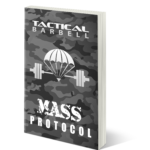 SE aka Strength-endurance aka muscular-endurance, is the ability of a muscle/muscle-group to repeatedly exert force against resistance. SE is discussed in-depth in Tactical Barbell I and Tactical Barbell II.
SE aka Strength-endurance aka muscular-endurance, is the ability of a muscle/muscle-group to repeatedly exert force against resistance. SE is discussed in-depth in Tactical Barbell I and Tactical Barbell II.
This article covers the following:
- An Alternate Method for Setting up SE Circuits
- SE for Beginners
- Conditioning & SE
- Programming Pull-ups/Chins
- Doubling Up for PFT
SE: AN ALTERNATE SET-UP
In ideal conditions SE is set-up circuit style. You move from one station to the next, with minimal rest until all exercises are complete. This can pose problems in commercial gyms or if you’re short on equipment. You won’t always be able to take up and hold 6 to 8 pieces of equipment for the duration of your session. Try this alternative model instead. It’ll put some ‘fun’ back in SE and allow for more programming/equipment flexibility:
Pair exercises off. Preferably dissimilar muscle groups.
Perform exercise #1, perform exercise# 2. Rest for 0-90 seconds and repeat. Repeat until all three sets are complete.
Move on to the second pair of exercises. Repeat. Repeat until SE training is complete.
Here’s what that looks like… sample Cluster:
Dumbbell Bench Press/Goblet Squat
Overhead Press/Pull-ups
Good Mornings/Hanging Leg Raise
Barbell Rows/Overhead Barbell Squat
8 exercises in my cluster, and I’ve paired them off. Let’s say we’re doing Alpha circuits, day 1/week 1 – which is 3 circuits/10 reps each. Start with the first pairing – DB bench press & Goblet Squat. Set up your dumbbells/and or kettlebell for both movements. Perform 10 reps of DB Bench. Perform 10 Goblet Squats. Rest for roughly a minute and repeat. Repeat until all three sets are performed (remember it’s a 3 round circuit). That’s it, you’re done with DB Bench and Goblet Squats for the remainder of the workout. Now move on to the Overhead Press/Pull-ups. Put a nice light barbell close to your pull-up bar. Do the same thing – knock off 10 reps of OHP, move on and do the same with pull-ups. Rest for roughly a minute and repeat until all required reps have been completed. Move on to Good Mornings/HLRs….and repeat. You get the idea.
In the example above I used a RI of roughly 1 minute. Of course, with SE you’re allowed 0 to 90 seconds, so rest more or less as required. Yes, you can even rest in between each individual exercise within pairings if required. So let’s say you do a set of OHP, and you’re beat – can barely lift your arms. Take 0-90 seconds before moving on to pull-ups. This is likely going to be more of an issue come higher rep weeks – like 30s, 50s, etc. This alternate set-up gives you more choice and flexibility if you’re limited by equipment or busyness at commercial gyms.
SE FOR BEGINNERS
SE can be difficult for the uninitiated. If you’ve been operational for a while, you might see sets of 25-50 and think ‘too easy’, but for beginners even 5-10 rep circuits can be incredibly challenging. If you’re a beginner, try this;
Cut the reps in half.
That’s it. If using Alpha circuits weeks 1/2/3 are 5/10/15 reps rather than 10/20/30. Same thing applies to Bravo circuits. Still too tough? Cut down on the number of exercises in your cluster. Go with 6 instead of 8, etc. Take advantage of and use all your allowable rest interval time in between exercises. If you’re new to SE, don’t be a hero.
CONDITIONING & SE
I frequently get asked what type of conditioning is best used alongside SE-only blocks. If you haven’t already figured it out, the answer is E aka Endurance. LISS, Fun-Runs, rucking etc. It’s not a hard and fast rule, but generally lower intensity/longer duration sessions play well with SE. Don’t believe me? Go do Apex Hills the day after a Bravo circuit. There are exceptions – tempo runs like the Fast5 are usually fine. One of our clients refers to SE/E blocks as his ‘slow twitch’ blocks, which is fitting. Combining domains that push in the same direction energy & adaptation-wise is always an effective approach.
PROGRAMMING PULL-UPS/CHINS
Pull-ups or chins shouldn’t be neglected for very long if you’re operational. That might mean weighted pull-ups in your maximal-strength cluster as well as incorporating them in SE. Pull-ups/chins are a little too challenging for most using standard SE numbers. If that’s the case for you, try this instead;
- Figure out your pull-up maximum
- Figure out 25-30% of that number/round up or down
- This is your starting number for the SE block.
- Every week when reps are increased – add the same number to the original.
Here’s what it looks like using Alpha circuits. Private Bloggins can do 10 pull-ups total. 25% of 10 is 2.5, he decides to round up to 3. Week 1 of Alpha calls for 3 rounds of 10. Bloggins performs 3 sets of 10 for each exercise except for pull-ups – he does sets of 3 instead. Week 2, he adds 3 to that number so he’ll be doing sets of 6 pull-ups. Week 3, sets of 9. Alternatively he could’ve rounded down and gone with 2/4/6 instead.
DOUBLING UP FOR PFT
If you’re operational and PFT’s comin’ around – program SE to get the most bang for your buck. Include and double up on PFT exercise. Let’s say your PFT includes pull-ups/push-ups/sit-ups. Create a cluster like so:
Push-ups/Pull-ups/Sit-ups/Goblet Squats/Hyperextensions
Then double up on the PFT exercises like this:
Push-ups/Pull-ups
Goblet Squats/Sit-ups
Push-ups/Pull-ups
Sit-ups/hyperextensions
x 3 rounds (or as per SE programming)
This kind of set-up gives PFT exercises twice the attention per session. The above is an example – get creative, use your own department’s particular PFT exercises. Too easy.
KB
Get your hands on our brand-new bestselling Hypertrophy program – click HERE for your copy of Mass Protocol


Thank you, KB!!
I started a base building Block Yesterday using this approach and love it! Made it different and interesting and i really like that i’m done with a certain piece of kit in a short amount of time and feel like i’m hogging kit in the gym when i’m busy!
Great Stuff
I just finished reading TBII after reading TBI and Ageless Athlete. Excellent resources. Thank you. I have a question about HR. For Endurance you recommend maintaining between 50 – 70% of MHR. I’m a very active 73 year old athlete, and using 208 – (.7 x age) puts me between 79 and 110 bpm. My resting HR is 47 bpm. So, my question is, should I be looking at a different range? At my age It doesn’t take a lot of effort to be at 110bpm, and I’m in pretty good shape. What do you recommend?
Long time since asked but this is the issue with that formula…it is very inaccurate as a way of calculating max, aerboic zones etc etc…
The best approach for outliers like yourself is to consider the “can I have a conversation” test and get a feel for what that looks like you…
I was recently hired as a contractor/ SC in a military unit. Your programming makes more sense now than ever. TB is born from experience and I see it’s true!